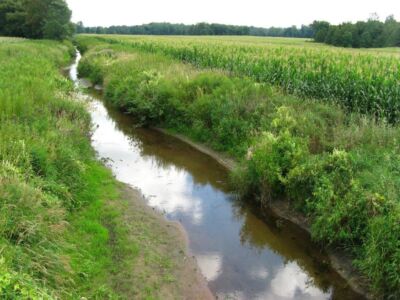Buffers along Water Courses Protect and Improve Water Quality
What are buffer strips?
- Buffer strips are permanently vegetated areas adjacent to open watercourses and wetlands, such as drainage channels, streams, rivers, ponds, and lakes. They are designed to help separate natural ecosystems from agriculture and developed areas to reduce the risk of contaminated runoff entering surface water. They may include trees, shrubs, grasses or wildflowers and can range from three to 30 m or more in width.
How buffers help water quality
- Bank stabilization – The roots of grasses, shrubs and trees provide bank stability, which help prevent erosion and stream siltation (the increased concentration of suspended sediments and to the increased accumulation (temporary or permanent) of fine sediments on bottoms where they are undesirable).
- Sediment filtering –Soil particles and other forms of pollution (i.e.: nutrients from manure and fertilizer, pesticides, bacteria and pathogens) become trapped in buffers before entering the water. Without this, sediment in rivers can smother fish spawning areas and benthic invertebrates (bug life) that live on creek bottoms.
- Plant uptake (pollution transformers) – Nitrates and phosphorus are transported in solution over and through the soil. Deep rooted vegetation and chemical and biological activity in the soil can capture and transform these soluble contaminants into less harmful forms.
- Flood protection – Buffers slow down excess surface water so that it can soak into the ground and recharge the groundwater supply. By storing water, treed areas reduce the risk of flooding during storm events and moderate the rate of runoff from snowmelt.
- Infiltration – Water stored in buffers is slowly released to surface water after the run-off period. This helps maintain higher base flows in the stream for longer periods of time.
How buffers improve stream health
- Habitat enhancement – Roots and branches from streambank vegetation provide cover for aquatic life. Shade from overhanging plants also helps cool and stabilize water temperature. Stable temperatures are important for the survival of species such as fish, amphibians and reptiles.
- Organic debris – Leaves falling into the water from surrounding vegetation are an important source of food for aquatic life. Organic debris also shelters fish and benthic insects.
- Natural stream bottoms – By filtering sediments, buffers prevent siltation of gravel and cobble stream bottoms and allow the natural pool/riffle sequence to be maintained. Riffles add oxygen to the water. Gravel streambeds that are free from silt buildup improve water quality and provide a healthy place where fish and aquatic invertebrates can thrive.
Other benefits of buffers
In addition to protecting watercourses, buffer strips provide forage and cover for land animals and make ideal wildlife corridors. They also provide habitat for pollinators and other beneficial insects. Finally, an established buffer strip adds value and beauty to a property.

Small buffer along Mud Creek

